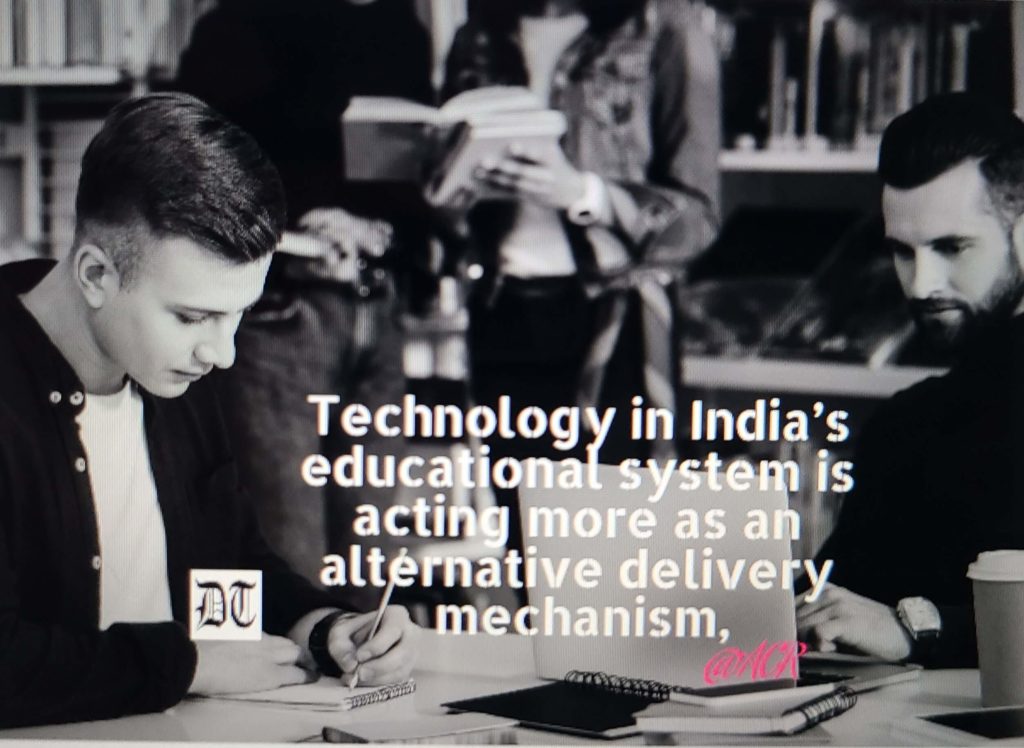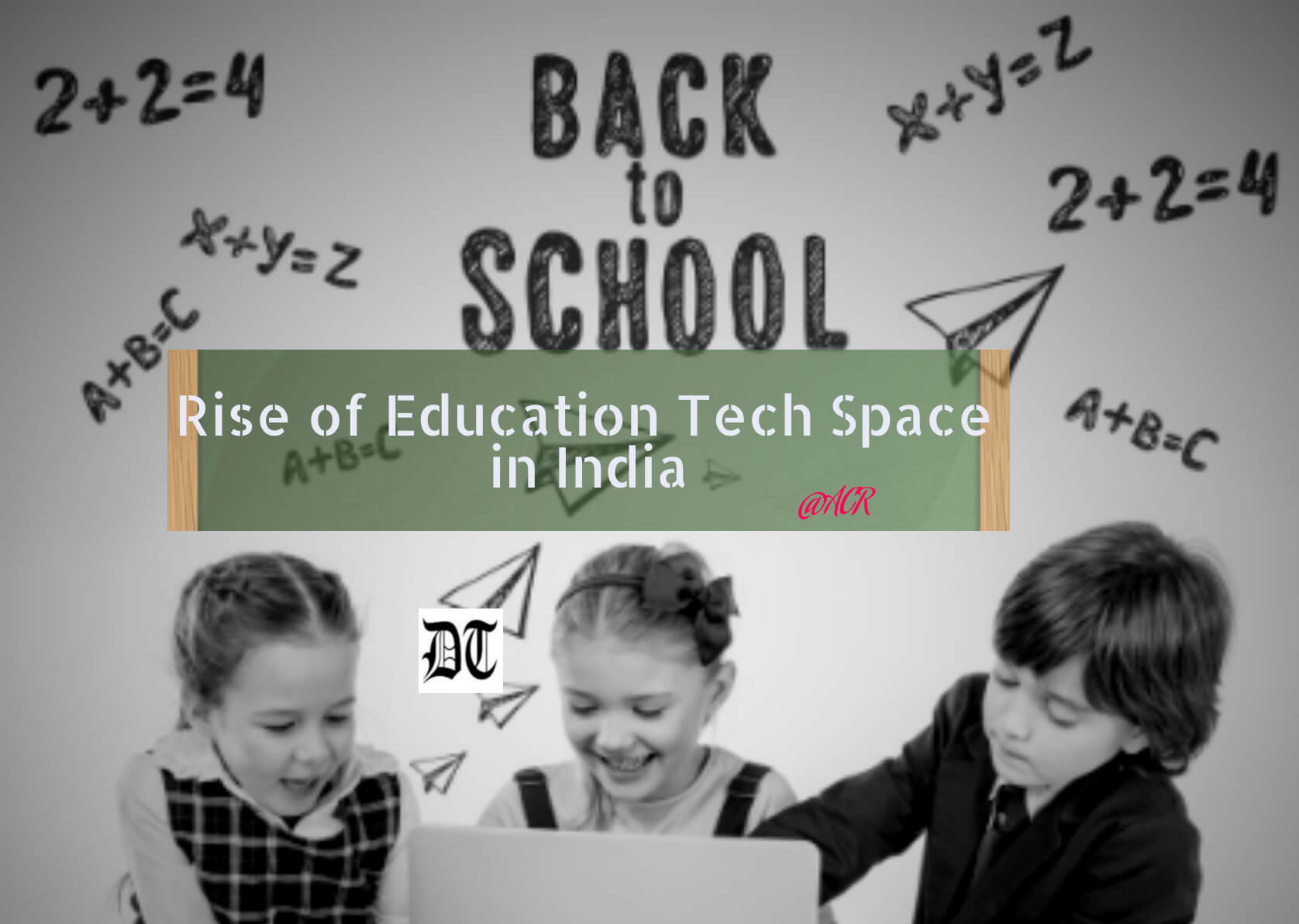Reading Time: 9 minutes
Meera explores and analyses the reasons for the rise of education tech space in India. An exclusive for Different Truths.
The normal classroom type of setup (i.e., the blackboard and the physical presence of both teachers and students) has grown phenomenally, leading to several students wishing to attain a degree. Indicating that especially for a country like India, the only way to achieve and become something in life is to be highly literate. It is under this backdrop that Edu tech companies like BYJU’S, TOPPR, UNACADEMY. UPGRADE, VEDANTU have emerged as big players.
· These companies started offering solutions at a cheaper price to its students
· Replacing the traditional classroom with online education
· At the comfort of your home
· Saving in the bargain, time and money that was spent on travelling.
In fact, some of these companies have achieved Unicorn (very prestigious) status.
The growth of this industry has been aided due to the government’s decision…
The growth of this industry has been aided due to the government’s decision to reduce its spending on the education sector.
This might be part of a well thought out process, of allowing the market forces to decide the cost of provision of education services, which would lead to greater competition and further drive businesses to improve services, reduce expenses thus providing better products for consumers.
Market-Based Reforms
A lot of countries have recommended market-based reforms, including reduction in government funding, deregulation of tuition fees and increased competition. The working and the phenomenal increase of the current Edu-Space in India is based on the basic market principles. They have started promoting online education as an inexpensive alternative to traditional approaches by:
1) Encouraging technology- based public-private partnership
2) Ease the process of registration of ed-tech ventures in the market space.
3) Personalised learning software, which adapts instructions to individual learner needs and interests.
4) Packaging content into distinct chunks
5) Delivering it to individual learners according to their individual needs
6) Using automation so that the process can be repeated.
7) This would transform society for the better.
All the above and more have helped in the phenomenal growth of this sector.
Financially Driven
Ed-Tech is financially driven, and sticks to the concept of privatisation, all based on the superior power of technology. From this perspective, ed-tech is neutral, and does not have a past nor is it political. It assumes positive impacts and is positioned as the answer to the issues and problems faced by administrators, faculty, students, teachers, and learning institutions.
Ed-tech as a scholarly field and as a practice will continue in their efforts to improve teaching and learning.
These programmes, consider the ideological, social, political, and economic content that surround the use of these technologies. Ed-tech as a scholarly field and as a practice will continue in their efforts to improve teaching and learning.
India During the pandemic
In 2015 Nobel Prize winner Amartya Sen said, in a gathering at the London School of Economics, “India is the only country trying to become a global economic power with an uneducated and unhealthy labour force.”
This has changed with respect to the education sector, as can be seen with the phenomenal growth of BYJU’S, TOPPR, UPGRAD and VEDANTU to name a few. This could be seen in their huge advertising budgets, BYJU’S in fact is one of the main sponsors of the Indian Cricket team.
The world is passing through a rough phase since the onset of the pandemic.
The world is passing through a rough phase since the onset of the pandemic. Education has been one of the hardest hit sectors, where schools, colleges, educational institutions, have been completely shut in its physical mode.
Though technology in education is not a new concept, the adoption has been at a break-neck speed during this period. Students need to become life-long learners to ensure they keep imbibing creative and transformative skills. Hence learning becomes more relevant especially when students want to learn at their own speed and time.
Prosperity Index
India ranks 94th in overall Prosperity Index rankings and 104th in Prosperity Index in Education (2018), around 3500 startups in India are catering to the education space and has received close to $700 million in 2018, 77% of total funding (between 2014-2018) have been in four ed -tech start- ups.
Digital evolution and the boom in smartphone adoption are expected to define the way Indian students learn.
Digital evolution and the boom in smartphone adoption are expected to define the way Indian students learn. Real time book updates, online tutoring, edutainment, online test preparation, web- based research and gamification: technology has changed our traditional education system in more ways than one, with more than 260 million enrolments, indicating that India has the world’s largest K-12(primary and secondary) education system [2018].
In 2018, the Indian ed-tech startup received close to $700 million in funding, an 85% jump from $375 million in 2017 (of which $230million was invested in BYJU’S alone).
In 2018, BYJU’S became the most valuable ed-tech company in the world at $3.6 Billion.
In fact, 66% of the total funding of $1.12 billion (between 2014-2018 was in one company BYJU’s). In 2018, BYJU’S became the most valuable ed-tech company in the world at $3.6 Billion. A unicorn status was conferred on it.
According to a Google-KPMG report, India’s online education market is set to grow at $1.96Billion and have around 9.6 million users by 2021. It is but natural that with these figures, investors are aggressively looking to fund this sector and make good returns. Besides BYJU’S the other companies are TOPPR, UNACADEMY AND VEDANTU, and many more.
Problems Peculiar to India
Every curriculum in India is exam driven and alternate evaluation processes are not trusted by society. Parents are still prioritising grades, leading students to resort to more study material and tuitions. Besides, jobs still demand conventional educational degrees recognised by designated educational boards. This makes it difficult for any company to create a business model that is both innovative and has the “Uber of Ed-tech” principle, so that entrepreneurs could win investors’ trust.
Is India losing the advantage of its young workforce?
Not only are many young Indians facing a dearth of decent jobs, but it turns out that many are unemployable too. Is India losing the advantage of its young workforce?
Online classes have made delivery of lessons convenient, but they still follow a classroom approach, the only difference is that mock tests and test preparations instead of being conducted at test centers are now being done in an online mode. Ed-tech startups in the discovery space are even helping parents search for tutors and institutions.
Technology in India’s educational system is acting more as an alternative delivery mechanism, while the process and system of education remain traditional, start-ups are providing a digital delivery of content in a more accessible way to almost all members of the society that have the purchasing power.

Indian Parents are Wary
Indian parents are still wary of innovative educational methodologies, they are open to their kids adopting courses offered by ed-tech startups, not as the exclusive source of education, but as a top up to their regular classroom books and tuition notes.
Indian startups mainly focus on the ‘rote’ system of learning.
The primary aim of the education system in India is to teach students to acquire and practice skills, so that they can make a living. Indian startups mainly focus on the ‘rote’ system of learning. This is one of the major flaws in the Indian education system. Risk taking is mocked in our society. Our testing and marking system needs to be built to recognize original contributions, in the form of creativity, problem solving, and valuable research and innovation.
The Way Forward
Comparing the public and private space in the educational field, one needs to note that both have to be on the same page for them to be mutually beneficial for each other. The phenomenal rise in the ed- tech sector has been the direct result of technology helping in attaining all the advantages of a free market economy.
They have a huge choice in deciding the sphere, the type, and the way they can enhance their skill.
They have a huge choice in deciding the sphere, the type, and the way they can enhance their skill. The new ed-tech companies have given them ample choice, both in the form of results as well as monetary packages. This has been aided by the huge numbers that are involved in this segment, giving an advantage to the ed- tech companies in the amount of funding they have garnered to provide an alternative to the old traditional brick and mortar system that existed earlier.
Private Space
The pandemic has been a game changer for the ed -tech space. The size of the industry has multiplied manifold, by 2022, it is anticipated to be, in excess of $2 billion, 37% of India’s population is between the age group 5-24 years. A report published by RedSeer and Omidyar Network in 2020 has stated that the user base of the ed-tech industry has doubled, there has been a 50% increase in the time spent online and a massive jump of 83% in the number of paid users.
BYJU’S – based out of Bangalore is a creator of India’s largest K12 learning app…
BYJU’S – based out of Bangalore is a creator of India’s largest K12 learning app, it offers highly effective tools and platforms for all ages and competitive exams like JEE, NEET, CAT, IAS, GRE, and GMAT, it has also bought over WHITEHAT Jr (an online coding and mathematics classes for children between the age 6-18).
UPGRAD based out of Mumbai, plans to close their books by March 2022, at a revenue of half a billion Dollars. Their emphasis is on the higher education space, which has grown during the pandemic at a phenomenal pace. Their aim being to deliver the best career outcomes and ensuring that learners get a good rate of interest on money invested.
TOPPR is in the same space as BYJU’S, based out of Mumbai, they emphasise on the quality and the timeliness of support.
Public Space
SWAYAM (The Study Web of Active learning for Young Aspiring Minds) in the public domain follows the three main principle of educational policy, like, Access, Equity, and Quality
DIKSHA (National Digital Infrastructure for Teachers) is another platform in the government domain. This portal makes sure that the benefits reach teachers in an equal and non- partial way.
MOOCS (Massive online open courses).
The UGC, a regulator that sets standards for higher education in India, has given its approval to increase the online learning content for 950 plus universities…
The UGC (University Grants Commission), a regulator that sets standards for higher education in India, has given its approval to increase the online learning content for 950 plus universities during the pandemic. The New Education Policy (NEP), which is being adopted in the Indian context, has in principle approved that 40% of the teaching content should be in an online manner.
Learners from two to three tier cities will take advantage of the various online skilling programmes as they do not require travel or relocation to a metro area. The present education system of “one size fits all” is expected to fade away gradually to be replaced by a more personalised learning experience.
Cloud Platform
Many educational institutions in the country including ed-tech companies are working closely with the Central government, State government, and educational boards to make the cloud platform relevant. They are also being driven by different technologies like BlockChain, Artificial Intelligence, etc.
Thus, what is required:
1) Equipping teachers to alternative teaching methods
2) Project based grading rather than examination-based grading
3) Gamification of learning
4) Applying various theories and concepts to everyday context in a student’s life
5) Hands on investigation and analysis
6) Do it yourself projects
7) Group study exhibitions
Conclusion
The study concludes that the central and state education boards should readily adopt the new digital system of education, making changes in its outlook, as well as adopt new norms with respect to the basic requirement for higher studies. This should be universally accepted across the school curriculum so that all stakeholders would then trust the new system of education. The Government needs to provide an impetus to alternative learning in schools, as it is only then that ed-tech start- ups would actively look at designing products for this sphere and would be in a commanding position to create a significant impact on improving educational standards. The responsibility lies with both the public and private space in moving together, to achieve higher skills for greater employment opportunities for the Indian workforce.
Globally, tech startups have been able to disrupt and expand markets across sectors only in those countries where the business framework is not restricted by Government regulations…
Globally, tech startups have been able to disrupt and expand markets across sectors only in those countries where the business framework is not restricted by Government regulations and there is no resistance to change, they increased the market size of their respective sectors by modernising the segments and expanding them so that businesses could grow and innovate. One should be careful that this space should not go the Chinese way when in a sudden move the Chinese Government clamped down on its Edu tech space and banned all online learning, as they thought it was putting a great burden on young children.
In the case of India this may not happen as both the government and the private ed tech companies, seem to be moving in the same direction, basically implying better opportunities for our children to enhance their skill at cheaper costs, and at the same time they would have greater opportunities to be gainfully employed.
Note: Tanisha Arya from Delhi Public School R.K. Puram assisted me in the above article
Visuals by Different Truths
—














